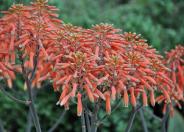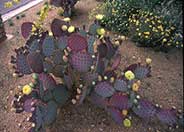
Common name:Little River Wattle
Botanical name:Acacia cognata 'Cousin Itt'
This low shiny ground cover has a low mounding form. It does well in both hot inland or coastal settings, needing little water or care once established. It is a great addition to Mediterranean style gardens, excellent for hillside plantings, rock gardens, mass plantings and with dry creek beds. It is small in stature growing less than 2 feet tall and 4 feet wide. It looks like side-ways bamboo.

Common name:Golden Barrel Cactus
Botanical name:Echinocactus grusonii
Globe shaped trunk, vertical ribs lined with thick rows of golden spines, Slow to 3', Containers, Full sun but prefers some shade in low desert, well drained soil, rots with poor drainage,,

Common name:Coral Aloe
Botanical name:Aloe striata
More attractive than saponaria. Great flower display in late winter. A slow to moderate grower forms a large rosette. Fleshy leaves are pale gray and broad at the base. Leaves have fine longitudinal lines and also pink margins. Clusters of flowers are coral red to orange on 3' stalks. South African native. Best with filtered sun. Frost tender but more cold hardy than saponaria.

Common name:Blue-blade
Botanical name:Opuntia violacea santa-rita
Opuntia vio. santa-rita is a cacti. Though perfectly hardy in the coldest winters, they need perfect drainage to survive winter freezes and thaws. Does well when grown in raised beds.

Common name:Reed Grass
Botanical name:Calamagrostis foliosa
This tufted perennial bunchgrass is native to the northern California coastal scrub. It forms a beautiful, dense mound of grey greeen leaves that reach 2' tall, with showy arching flower stalks to 3' tall. Reed Grass leaves assume an attractive purple
coloration in the fall and winter. This evergreen should be grown under sun, with little or no summer watering required. -Monterey Bay Nursery

Common name:Purple Prickly Pear
Botanical name:Opuntia macrocentra
Purple Prickly Pear is a cactus that has thick, fleshy, lavender violet colored pads instead of leaves. Watch out for spines. Red and yellow flowers bloom in spring and summer, followed by reddish purple fruit. This plant reaches 3' tall and wide. This plant is very heat tolerant and becomes drought tolerant once it's established.
Designer: Linda McSwain (retired)
Photographer: Vicki Anderson
Incorporate compost 6" into your soil to retain water, reduce compaction, feed earthworms, and provide valuable nutrients to your plants.
Remove irrigation water and fertilizer from areas where you don't want weeds to grow.